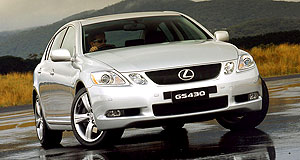First drive: Lexus GS grabs V6 and V8 power
BY TIM BRITTEN | 4th Mar 2005

The outgoing, second-generation GS – the first incarnation never made it to Australia – was the darling of the motoring press when it arrived in 1997, with rear-drive dynamics combined with a lusty inline six-cylinder engine to create what was seen as a genuine challenge to the Europeans.
But after a brief flare in the two years following its launch, the GS went into a steady decline as other new Lexus models, and some excellent new rivals, asserted their significance. In 2004, the Toyota luxury arm sold just 116 GS300s in Australia.
The inline six-cylinder engine was seen as central to the car’s character. It brought many a BMW reference, reinforced by the fact that the smaller, 3 series challengers in the IS200 and IS300 models also sported inline sixes.
Now, enter the all-new GS and exit the inline six.
The latest GS series resorts to V6 (GS300) and V8 (GS430) engines in its aim to re-establish the brand’s presence in the mid-size luxury market. Lexus talks about adopting V-shaped engines to save under-bonnet space and allow for improvements in weight distribution.
The new series will be lined up against formidable talent such as BMW’s 5 series, the Mercedes-Benz E-Class and Audi’s new A6. It spans a price range starting $5000 lower than before at $95,000 and extending to $137,000.
And, like Mercedes and BMW, it retains a rear-drive configuration, at least for the present. All-wheel drive has been developed for the GS and was mentioned at the car’s first pre-release airing at the Detroit motor show in 2004, but does not yet make an appearance in Australia.
Longer, wider and lower, with a longer wheelbase than the previous model, the new GS represents a worthwhile styling advance over the somewhat stodgy appearance that crept over it in the last few years.
Passenger space and comfort have been upgraded, while new technology, such as the glare-resistant electro-chromatic instruments, makes an appearance. All models also get a monitor that shows what’s immediately behind the vehicle when reverse is selected.
A lot of technology is thrown into the mix to create the new GS. The 3.0-litre V6 used in the GS300 version shares its 2.995-litre displacement with the Lexus ES300 engine but is a completely new design. It adds direct fuel injection to an already extensive list of advanced engineering features that include variable valve timing on both inlet and exhaust valves to extract impressive power and torque figures.
The all-alloy V6 is also 39kg lighter the previous cast iron inline six.
This adds to the power-weight ratio while notching power from 166kW to 183kW and, even more impressively, increasing torque from 298Nm to a quite astounding 310Nm. What’s more, at least 90 percent of that torque is available in a power band stretching from 1800rpm to 6300rpm.
The 4.3-litre V8 engine used in the top-of-the-range GS430 model is also lighter (13kg) than the previous inline six. A development of the engines used in the LS430 and SC430 models, it winds out essentially the same outputs, with 208kW and 417Nm.
Both engines are supported by a sequential-shifting six-speed automatic transmission.
Meantime, the new body, and the new drivelines, are supported by a reworked suspension system that replaces the previous wishbone rear suspension with a multi-link arrangement. The double wishbone front suspension is a development of the previous model, while the steering is now electrically power assisted.
In the high-series GS430, a new Variable Gear Ratio Steering system (VGRS) is linked into the stability control – fitted standard across the new GS range – to intervene in the case of impending understeer or oversteer.
The system, tagged Vehicle Dynamics Integrated Management (VDIM) by Lexus is, however, upstaged by the ‘active’ steering seen in the new BMW 5 series, which also manipulates the steering to control wayward behaviour.
The GS430 also has ‘active’ Adaptive Variable Suspension (AVS), that helps keep it level when cornering, yet allows a soft, smooth ride when progressing in a straight line.
All GS models also get a Mercedes-like pre-collision system that activates the safety systems – it tensions the seatbelts and is able to increase the braking force, if a collision is imminent.
Top of the line is he GS430 Sports Luxury that gets, in addition to the 4.3-litre V8, 18-inch alloy wheels, VDIM, AVS and VGRS.
2005 Lexus GS pricing:
GS300 Sports (a) $95,000
GS300 Sports Luxury (a) $112,100
GS430 Sports Luxury (a) $137,000